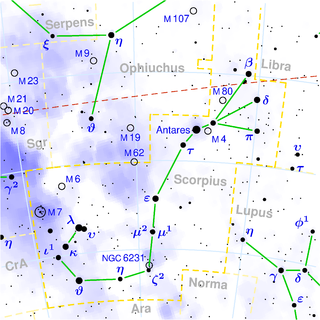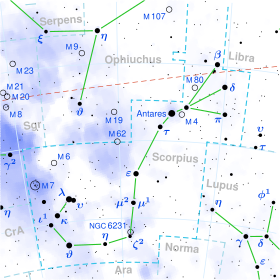
X Sagittarii is a variable star and candidate binary star system in the southern constellation of Sagittarius, near the western constellation boundary with Ophiuchus. It has a yellow-white hue and is visible to the naked eye with an apparent visual magnitude that fluctuates around 4.54. The star is located at a distance of approximately 950 light years from the Sun based on parallax, and is drifting closer with a radial velocity of −10 km/s. The star has an absolute magnitude of around −2.85.

Rho Scorpii is a double star in the constellation of Scorpius. It has an apparent visual magnitude of +3.87, which is bright enough to be seen with the naked eye. Based upon parallax measurements, it is located approximately 472 light years from the Sun. At that distance, the visual magnitude of the system is reduced by 0.07 due to extinction from interstellar dust. It is a member of the Upper Scorpius OB association.
Psi Scorpii, which is Latinized from ψ Scorpii, is a star in the zodiac constellation of Scorpius. It is white in hue and has an apparent visual magnitude of 4.94, which is bright enough to be faintly visible to the naked eye. Based upon parallax measurements, it is located at a distance of around 162 light years from the Sun. Data collected during the Hipparcos mission suggests it is an astrometric binary, although nothing is known about the companion. The system is drifting closer to the Sun with a radial velocity of −5 km/s.
Chi Scorpii, Latinized from χ Scorpii, is a single star in the zodiac constellation of Scorpius. It has an orange hue and can be faintly seen with the naked eye with an apparent visual magnitude of 5.24. Based upon parallax measurements, this star is around 448 light years from the Sun. The star is drifting closer with a radial velocity of −23.6 km/s.

CS Camelopardalis is a binary star in reflection nebula VdB 14, in the constellation Camelopardalis.
HD 90853 is a single star in the southern constellation Carina. It has the Bayer designation s Carinae, while HD 98053 is the identifier from the Henry Draper catalogue. This is a variable star with an apparent visual magnitude that ranges from 3.36 down to 3.51, and thus is bright enough to be visible to the naked eye. It is located at a distance of approximately 1,340 light-years from the Sun based on parallax, and has an absolute magnitude of −4.44. The star is drifting further away with a radial velocity of +9 km/s.
HD 125288 is a single star in the southern constellation of Centaurus. It has the Bayer designation v Centauri ; while HD 125288 is the star's identifier in the Henry Draper catalogue. The object has a blue-white hue and is faintly visible to the naked eye with an apparent visual magnitude of 4.30. Based on parallax measurements, it is located at a distance of approximately 1,230 light years from the Sun. This is a candidate runaway star that is moving to the west and falling back into the Galactic plane. It has an absolute magnitude of −3.56.
KW Sagittarii is a red supergiant, located approximately 1,900 parsecs away from the Sun in the direction of the constellation Sagittarius. It is one of the largest-known stars. If placed at the center of the Solar System, the star's surface would engulf Mars.

Zeta Cephei is a star in the constellation of Cepheus. Zeta Cephei marks the left shoulder of Cepheus, the King of Joppa (Ethiopia). It is one of the fundamental stars of the MK spectral sequence, defined as type K1.5 Ib.
HD 41534 is a binary star system in the southern constellation of Columba. It is dimply visible to the naked eye with a combined apparent visual magnitude of 5.65. The distance to this system is approximately 950 light-years based on parallax, and it is receding from the Sun with a radial velocity of +93 km/s. This is a runaway star system with an unusually high peculiar velocity of 187.6+12.2
−13.8 km/s. It is thought to have been ejected from the OB association Sco OB 1 approximately 14 million years ago.

NO Aurigae is a pulsating variable star in the constellation Auriga. It is an unusually-luminous asymptotic giant branch star about 3,500 light years away.

Zeta1 Scorpii is a B-type hypergiant star in the constellation of Scorpius. It has an apparent visual magnitude which varies between 4.66 and 4.86. It is a member of the Scorpius OB1 association, and the open star cluster NGC 6231, also known as the "Northern jewel box" cluster. Around 36 times as massive as the Sun, it is also one of the most luminous stars known in the Galaxy, with an estimated bolometric luminosity of around 850,000 times that of the Sun and a radius 103 times that of the Sun.

Sigma Ophiuchi, Latinized from σ Ophiuchi, is a single, orange-hued star in the equatorial constellation Ophiuchus. Its apparent visual magnitude is 4.31, which is bright enough to be faintly visible to the naked eye. The annual parallax shift of 3.62 mas as seen from Earth provides a distance estimate of roughly 900 light years. It is moving closer to the Sun with a radial velocity of −28 km/s.

Theta Delphini, a name Latinized from θ Delphini, is a single star in the northern constellation of Delphinus. It has an apparent visual magnitude of about 5.7, meaning that it is just barely visible to the naked eye under excellent viewing conditions. The distance to this star is approximately 2,050 light years from the Sun based on parallax. It is drifting closer with a radial velocity of −15 km/s.

1 Puppis is a single star in the southern constellation of Puppis. It lies in the northern part of the constellation at a distance of about 790 ly, east of Aludra in Canis Major and just north of the white supergiant, 3 Puppis. This object is visible to the naked eye as a faint, red-hued star with an apparent visual magnitude of 4.59. It is moving further from the Earth with a heliocentric radial velocity of +32.4 km/s.

N Scorpii, also known as HD 148703, is a solitary, bluish-white hued star located in the southern constellation Scorpius. It has an apparent magnitude of 4.23, making it readily visible to the naked eye. N Scorpii was initially given the Bayer designation Alpha Normae by Lacaille but it was later moved from Norma to Scorpius. N Scorpii is currently located 550 light years away based on parallax measurements from the Hipparcos satellite and is part of the Upper Scorpius–Centaurus region of the Scorpius–Centaurus association.

GX Velorum is a solitary variable star in the southern constellation of Vela. It is visible to the naked eye as a faint, blue-white hued star with an apparent visual magnitude that fluctuates around 4.99. Based upon parallax measurements, it is located approximately 4,200 light years distant from the Sun, and is drifting further away with a radial velocity of +28 km/s. It may be a member of the Vela OB1 association of co-moving stars.

AH Scorpii is a red supergiant variable star located in the constellation Scorpius. It is one of the largest stars known by radius and is also one of the most luminous red supergiant stars in the Milky Way.

10 Persei is a blue supergiant star in the constellation Perseus. Its apparent magnitude is 6.26 although it is slightly variable.

V915 Scorpii is an orange hypergiant variable star in the constellation Scorpius.













